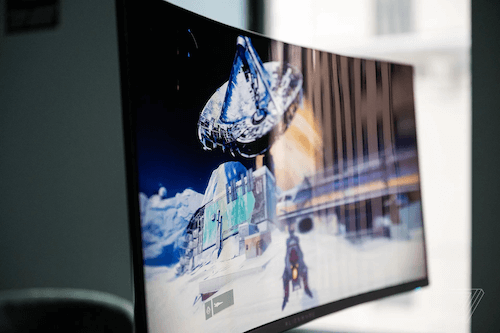High-end TVs and gaming monitors have been on a collision course for the past few years. The TV industry has pursued the best-looking picture, while monitors have opted for the fastest display tech. The crash that blends the two worlds together might have finally happened with Alienware’s latest curved gaming monitor, which has a QD-OLED screen. It’s the first device (of several more to come in 2022) to show what Samsung’s new QD-OLED display technology is capable of — for PC users, specifically.
The AW3423DW, as it’s officially (and clumsily) called, is now available for $1,299.99, beating Samsung and Sony’s forthcoming QD-OLED TVs to market. Actually, while it’s technically available, . So, those TVs might find their way into plenty of homes by the time people finally get their hands on this monitor.
But those will still be TVs, and this is a monitor. While this isn’t the first OLED targeted toward PC gamers, the AW3423DW is the kind of monitor that I have been waiting years for. I don’t want to have a tall TV on my desk, even if it is one of the “smaller” 42-inch LG C2 OLED TVs that are releasing this spring. The AW3423DW looks like a gaming monitor, with its immersive 1800R curve and 21:9 ultrawide (3440 x 1440) design. And, with a display capable of 175Hz refresh rate, it acts like one but has far better picture quality — and brightness — thanks to QD-OLED. At $1,299, Alienware’s pricing seems right on the money, coming in for less than next-gen TVs with many (but not all) of the same perks.
There’s a lot riding on QD-OLED panels given that Samsung Display claims they boast some key improvements over standard OLED. They promise a brighter image while still maintaining the excellent control over brightness that’s been a hallmark of OLED displays. What does that mean practically? The ability to be more accurate with brightness means QD-OLEDS can theoretically produce colors more accurately than traditional OLED displays. So, the reds and greens of nature that might look a little more muted on other displays will feel vibrant and more real on a QD-OLED. It comes down to the quantum dot layer (that’s the “QD” in the name), which converts blue light into red and green when needed, without the need for color filters typically used in standard OLED panels. Color filters tend to diffuse or dim the picture in some instances, especially when viewed at an angle. That’s not an issue here.
The AW3423DW delivers on the promises of QD-OLED with a bright picture (like, give-you-a-headache bright), unbelievably good viewing angles, and gorgeous colors. Jumping into the dense, green forests on Shadow of the Tomb Raider looked amazing. The first taste of what the technology is capable of is a delicious one, and I like it even more because it’s in a smaller design made for PC gamers.
As a gamer, I was consistently impressed with the HDR performance, too. OLEDs can struggle with HDR performance in brighter areas. The plume of an explosion won’t be quite as detailed in HDR on an OLED display versus LED. Yet, with a powerful PC rig attached, games look fabulous on the AW3423DW. Explosions popped. I tested out all of the games that I hoped would look great here, like Destiny 2, No Man’s Sky, Deathloop, and Cyberpunk 2077. Thanks to that 1800R curve, practically any game that puts the player in a world with a grand amount of scale looks phenomenal — especially considering that I’m looking at the AW3423DW from about one foot away. I’ve used curved gaming monitors before, but this QD-OLED panel’s combination of curve and vividness were the missing factors that pulled me further into my games. It might sound cliche, but I feel like I’m really seeing games as their makers intended.
Source: TheVerge


